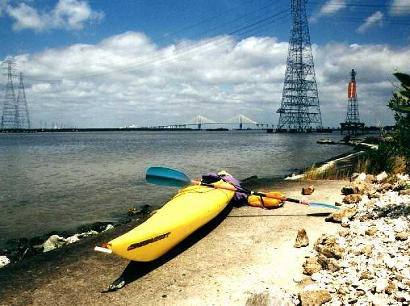|
“If
walls could talk” we wonder about old houses, pondering what stories
and secrets they could yield from yesteryears.
When it comes to little ol' Hog Island in the Houston Ship Channel,
we might contemplate, “If waves could talk ... or if sand could say
...”
The sand and surf of Hog Island, through two centuries, beheld myriad
scenes in state and local history, running the gamut from pigs to
petroleum.
To end an argument once and for all, the island really was named for
hogs so spell it, please, with one G. Even mapmakers and historians
have been known to double-G it, under the spell perhaps of a former
Texas governor. Jim
Hogg, however, had no connection with Hog Island, save for the
sound of his name. Not to say the rotund guv didn’t pig out on occasion,
as evident from his photos, but that’s irrelevant. |
Dr. Ashbel Smith,
who lived on the south rim of present-day Baytown
on Evergreen Road, acquired the island in the mid-1800s, turning it
into hog haven. Maybe there wasn’t enough room for Smitty’s piggies
to roam around on the Evergreen plantation, or maybe – just sayin'
– the swine didn’t smell fine. To the island!
Today, little is left of Hog island but you can still see it from
the Fred Hartman
Bridge on the Houston Ship Channel. Look eastward on the channel
for a lonely speck of land. Erosion and subsidence have claimed the
island that once provided a vital link between Baytown
and Morgan’s
Point. The Morgan’s Point Ferry landing on the island preceded
the Baytown-La Porte Tunnel which preceded the Fred
Hartman Bridge. |
 |
|
But the island
was more than a ferry connection, serving as a recreation spot as
well. We had picnics on the beach and went swimming off shore, in
spite of the huge tankers churning by.
"Watch out for the ships," our beach party chaperones would warn
us kids. "Undercurrents ... They'll pull you down under." Watch
out for high tide, too. A young couple parked one night on the beach
forgot about high tide and before they knew it, water was rushing
through the open windows of their car. (So much for romance on the
high seas.)
Before World War
II, community leaders in Baytown
envisioned Hog Island as the second Sylvan Beach. Plans for its
development, though, were dropped during the war and never picked
up again, postwar.
By the late Forties attention was focused on another travel connection
between Baytown
and La Porte
and getting off the island. By the time the Baytown-La Porte Tunnel
opened upstream in 1953, the concept of turning Hog Island into
a tourist attraction was all but forgotten.
Giving Hog Island its due, it has an multi-faceted history. Before
the hogs were turned loose, a steamboat landing operated on the
island, and a whole lot of Houston-to-Galveston
shipping activity went on.
In the early 1900s Hog Island played a pivotal role in the oil boom
and housed a boarding house for Goose
Creek oil field workers.
John Gaillard, who bought the island from the heirs of Ashbel Smith,
had been leasing it for grazing his livestock. In Tabbs Bay, which
separated his home from the island, Gaillard had noticed bubbles
but thought they were stirred up by buffalo fish. Royal Matthews,
a friend from La
Porte, rowed over one day, noticed the bubbles and lit a match.
Natural gas, not buffalo fish, will ignite when you do that. Natural
gas bubbling up in a bay also will give a hint about the possibility
of oil down below.
There was.
The first offshore
drilling in Texas occurred in Gaillard’s
favorite fishing hole while the Goose
Creek oil field sprang up in his front yard and all around.
The first barge load of Goose
Creek oil sailed from the landing on Hog Island. Ross Sterling’s
pipeline company routed crude from the Goose
Creek field to the ship channel via Hog Island, installing two
lines of pipe across Tabbs Bay. The oil emptied into cypress storage
tanks on the island, and tankers received the oil through a line
extending from the tanks.
And that’s when the industrial revolution began in Baytown.
Little ol'
Hog Island wasn't for hogs any more.
© Wanda Orton
Baytown
Sun Columnist
"Wandering" July
1, 2012 columns
|
| Texas
Escapes, in its purpose to preserve historic, endangered
and vanishing Texas, asks that anyone wishing to share their local
history, stories, and vintage/historic photos, please contact
us. |
|
|
